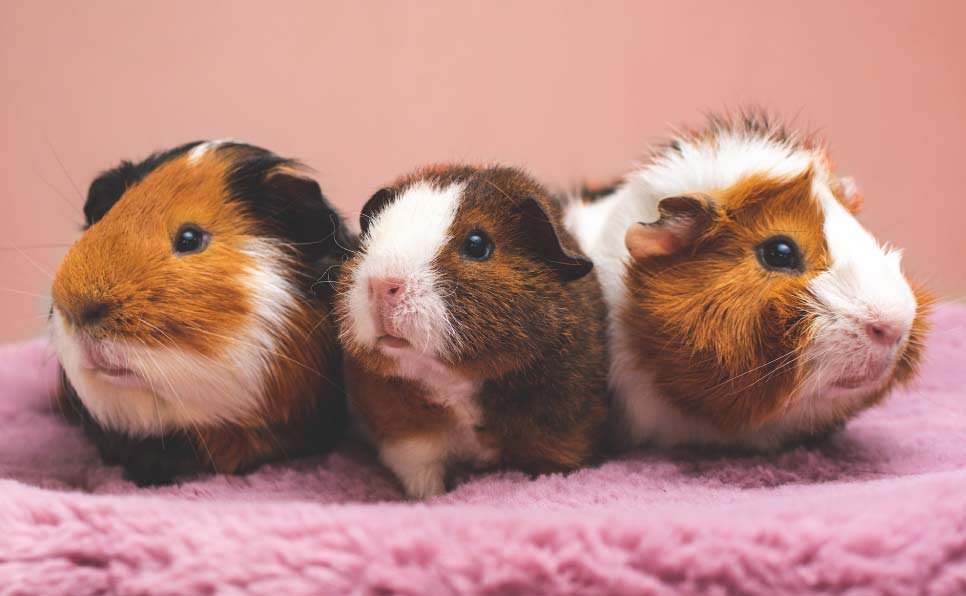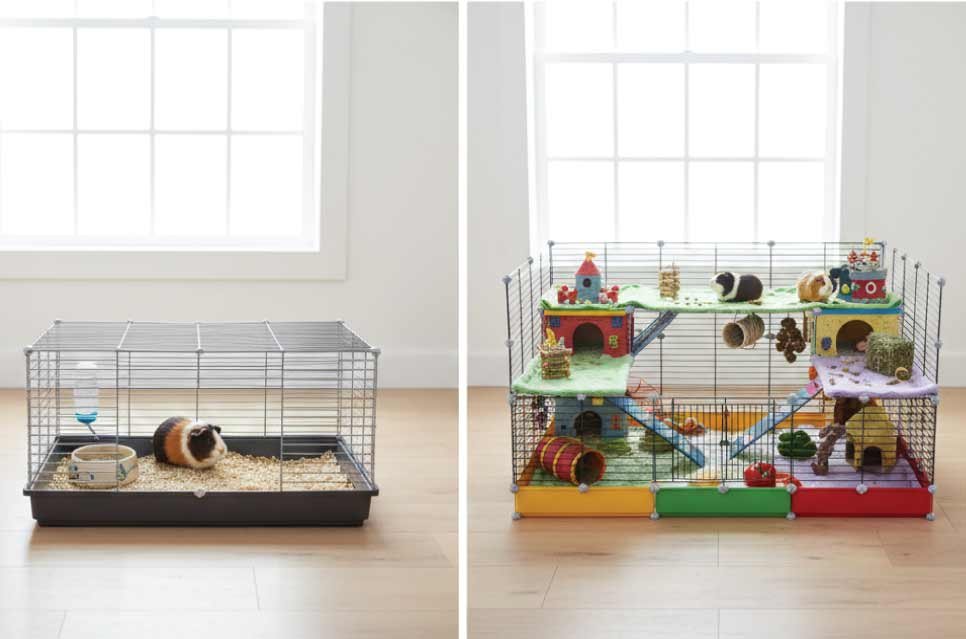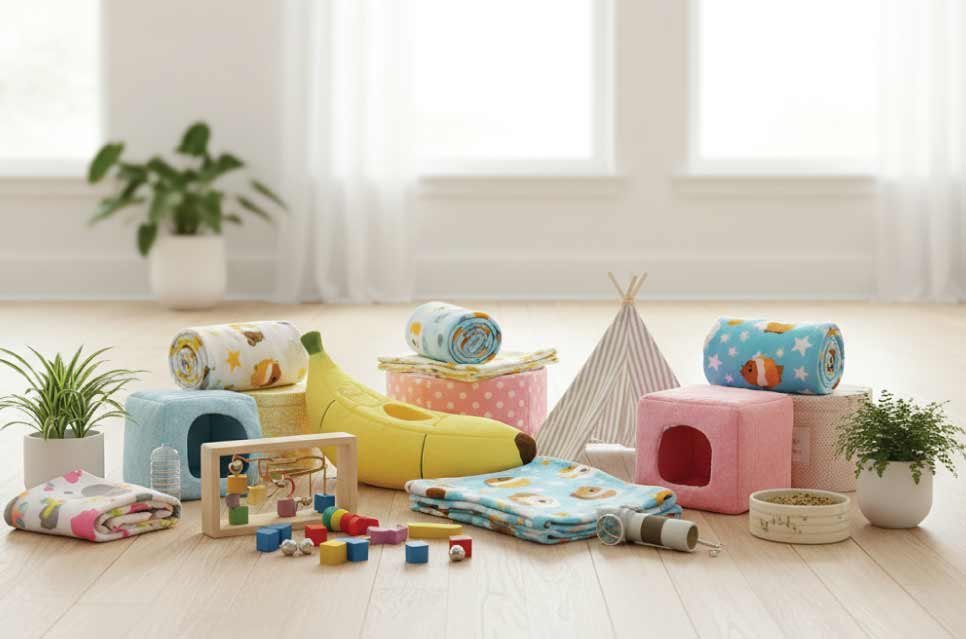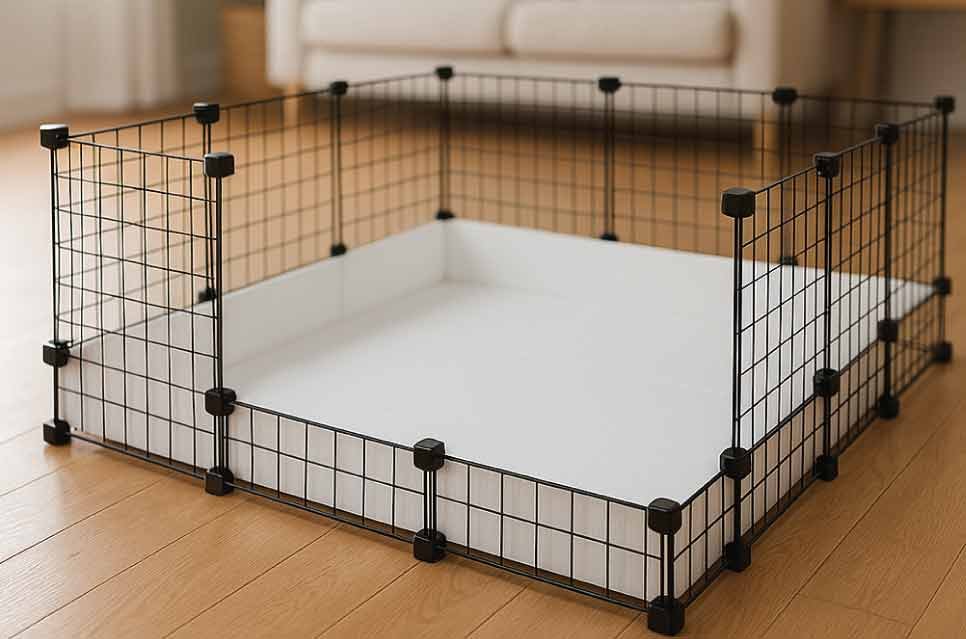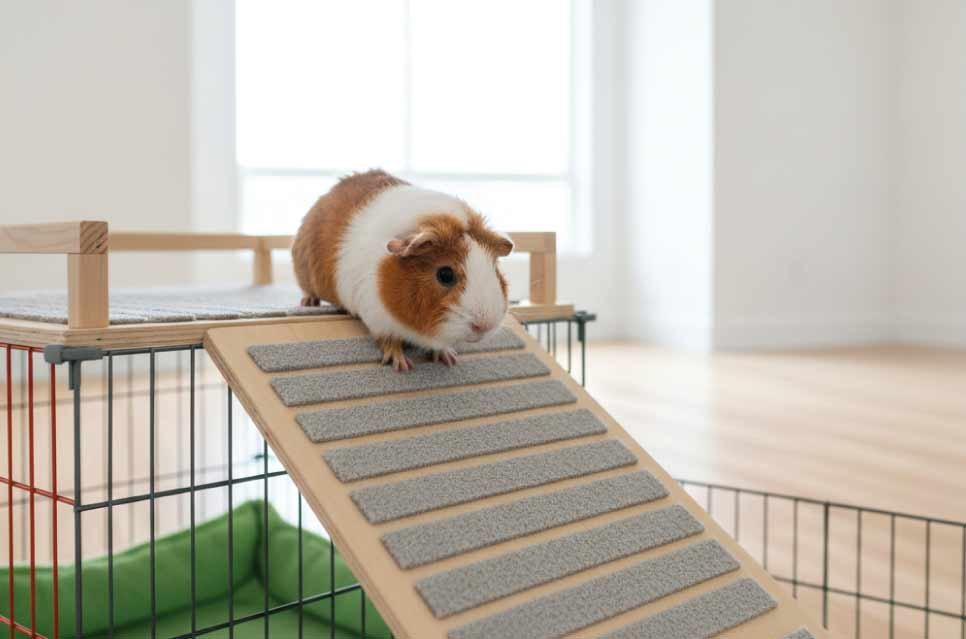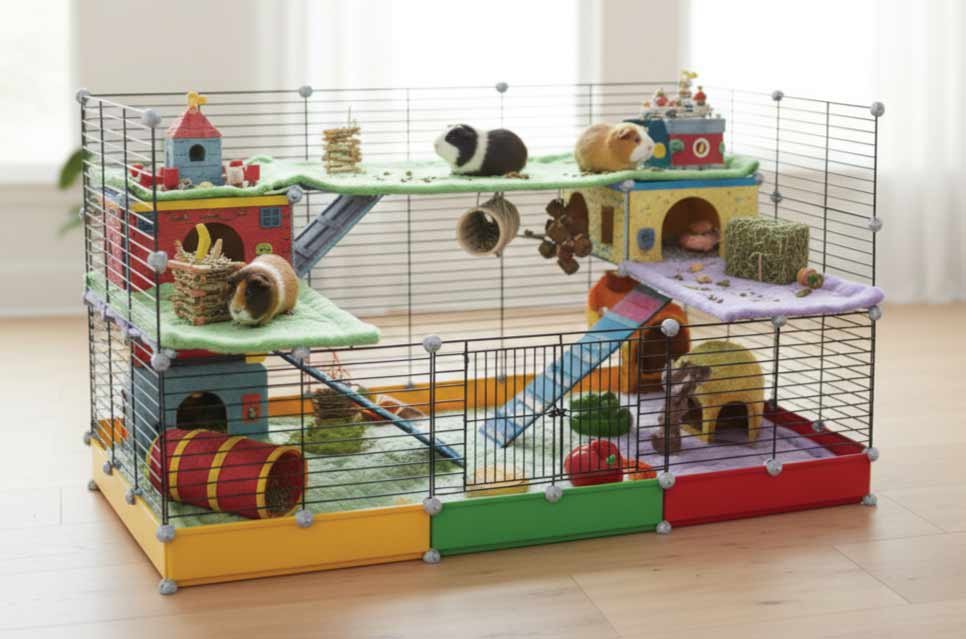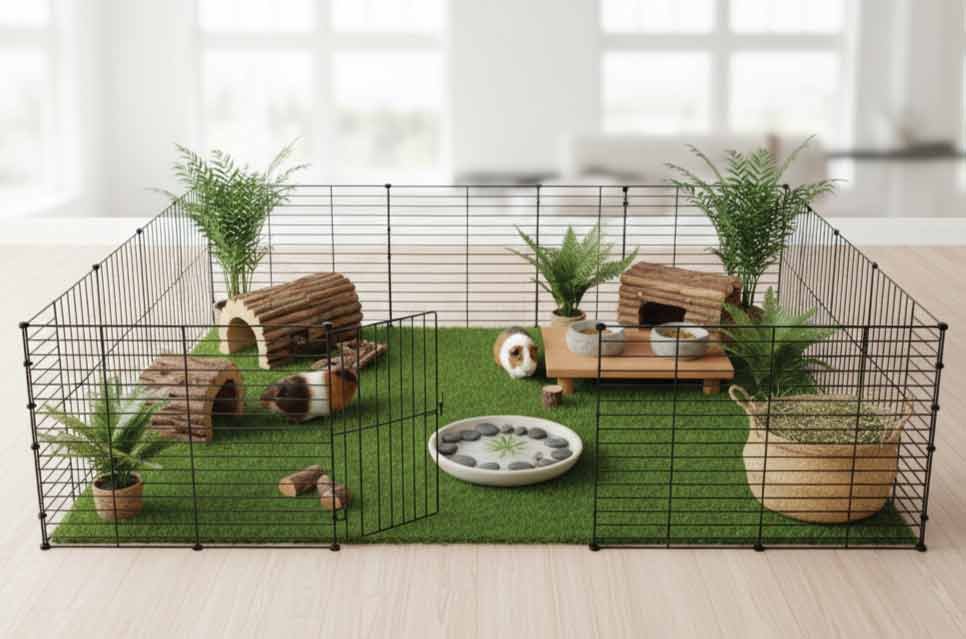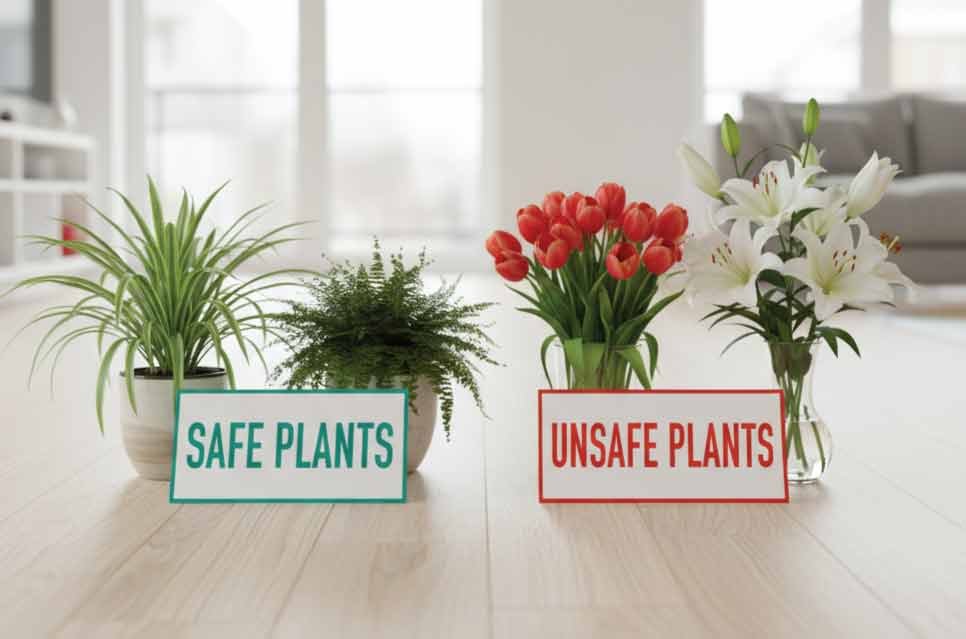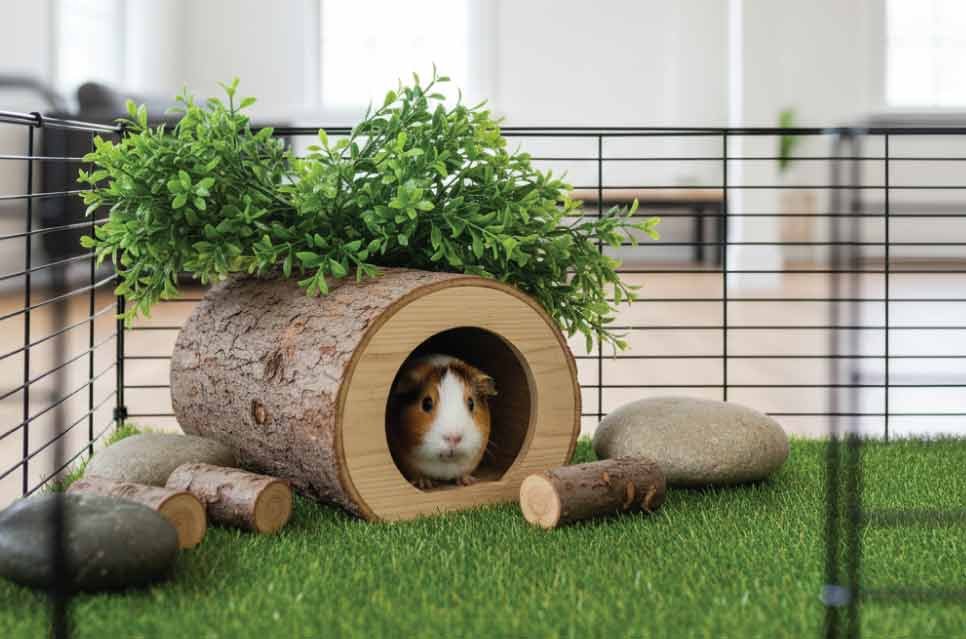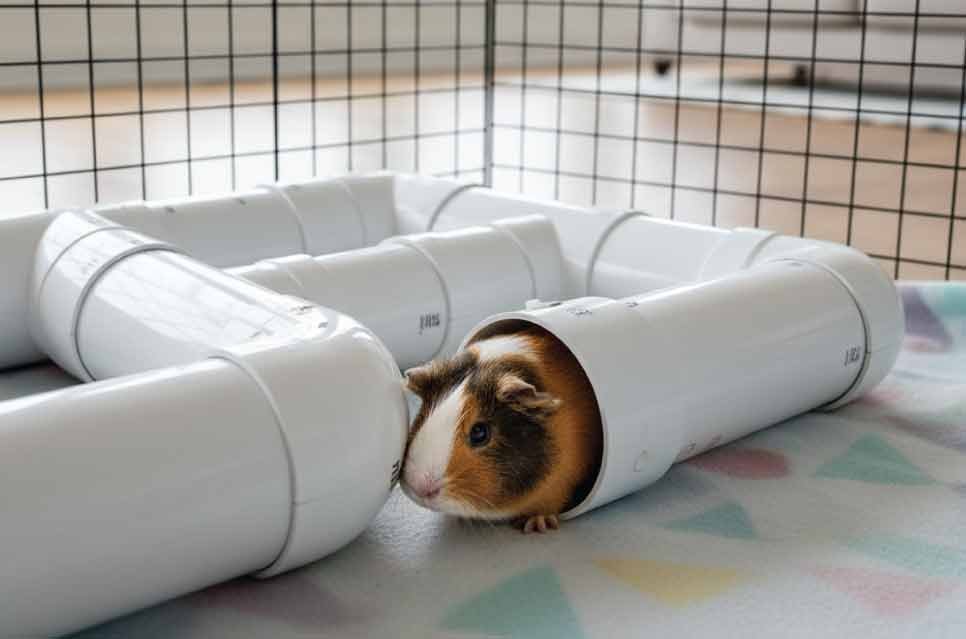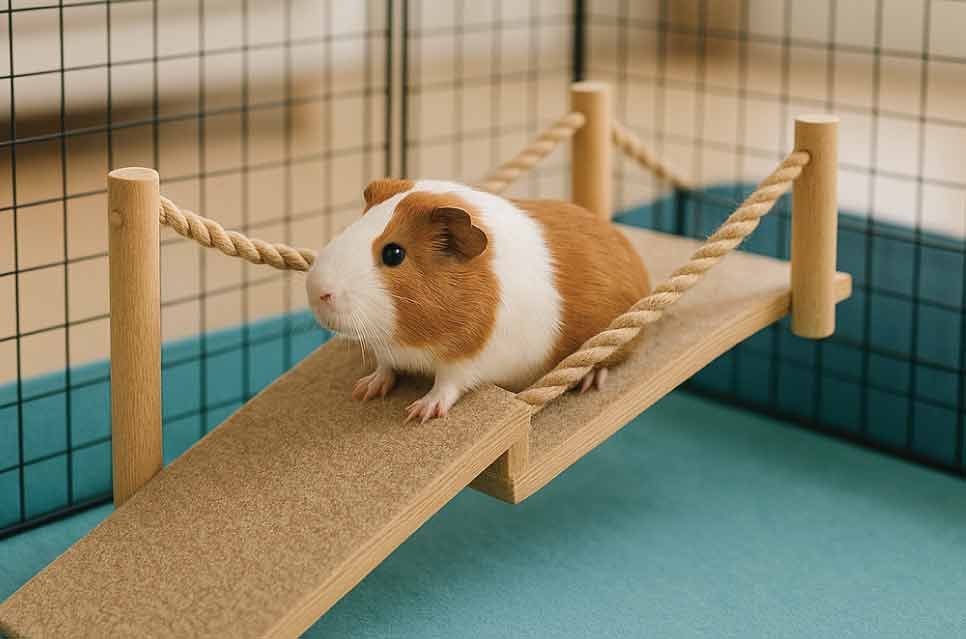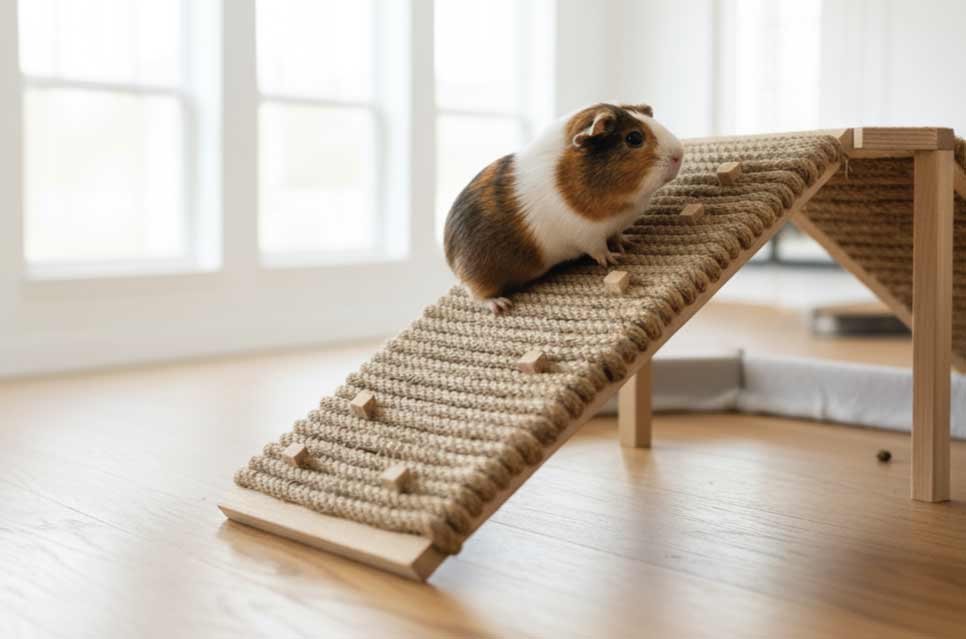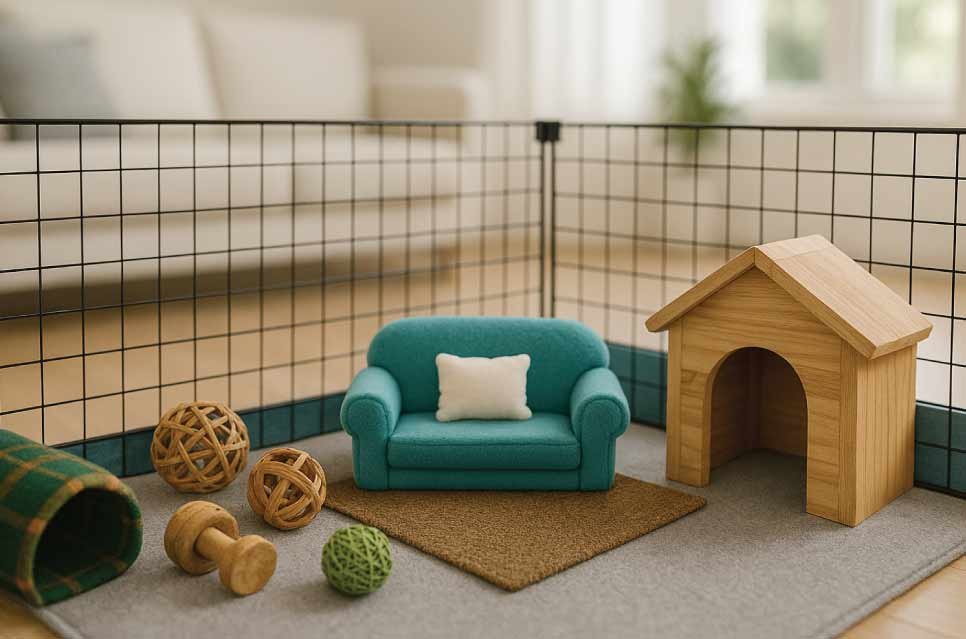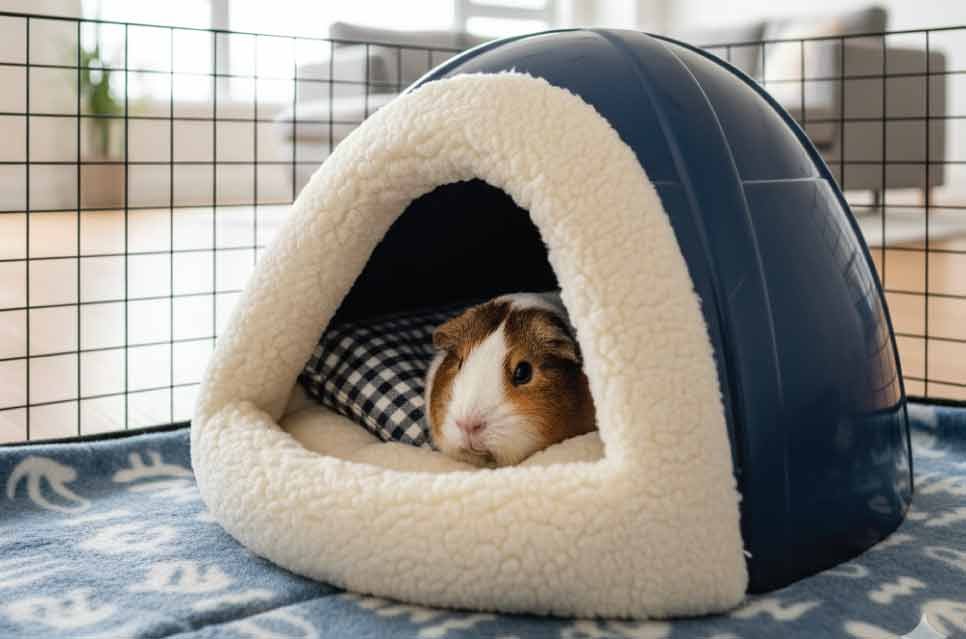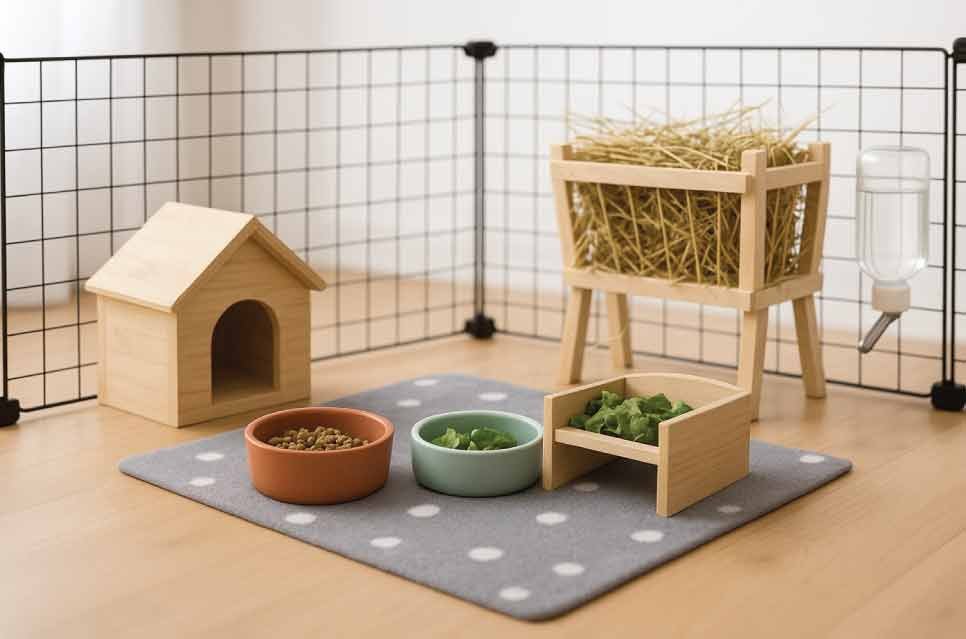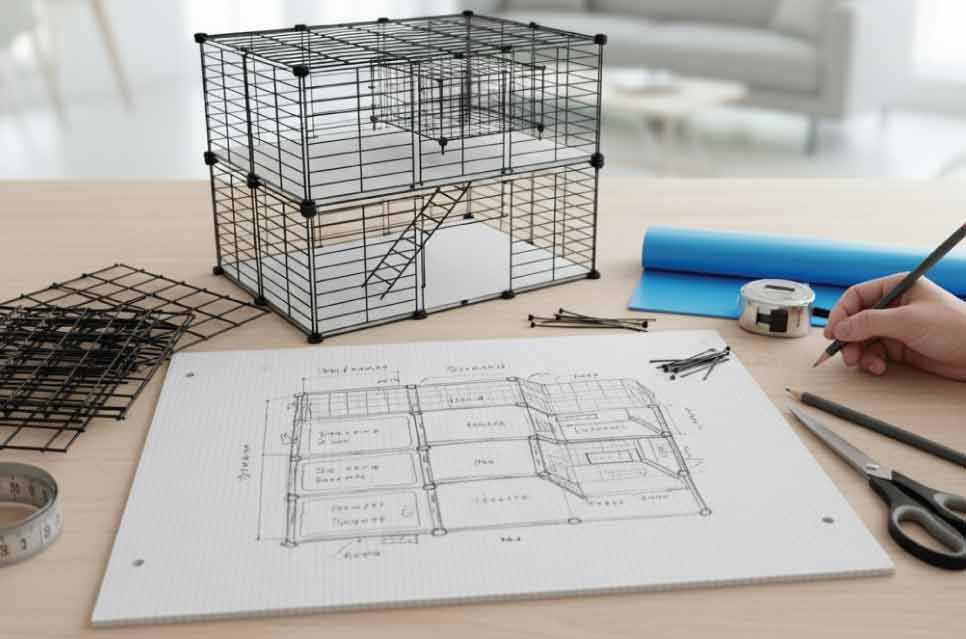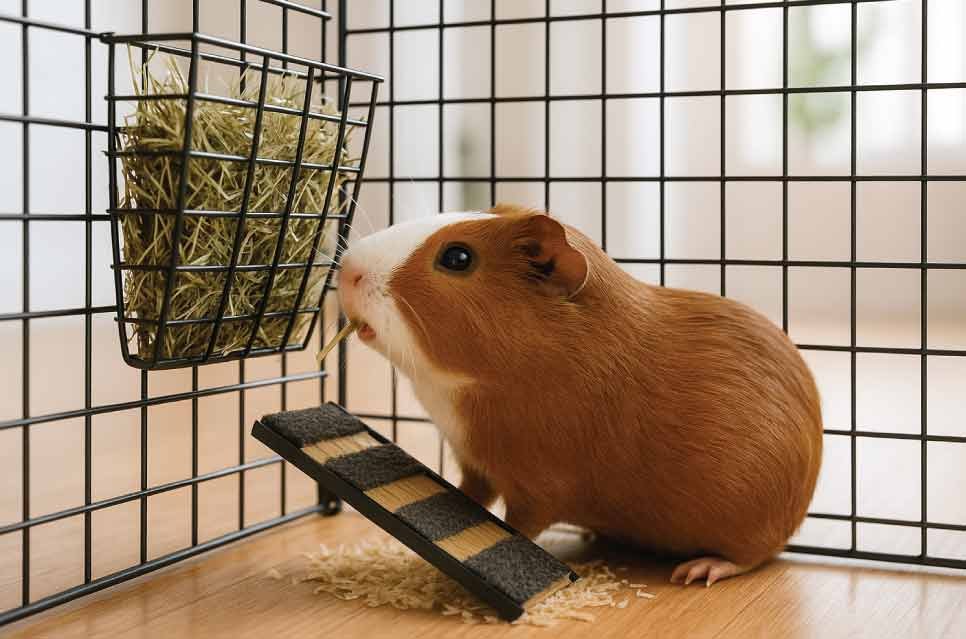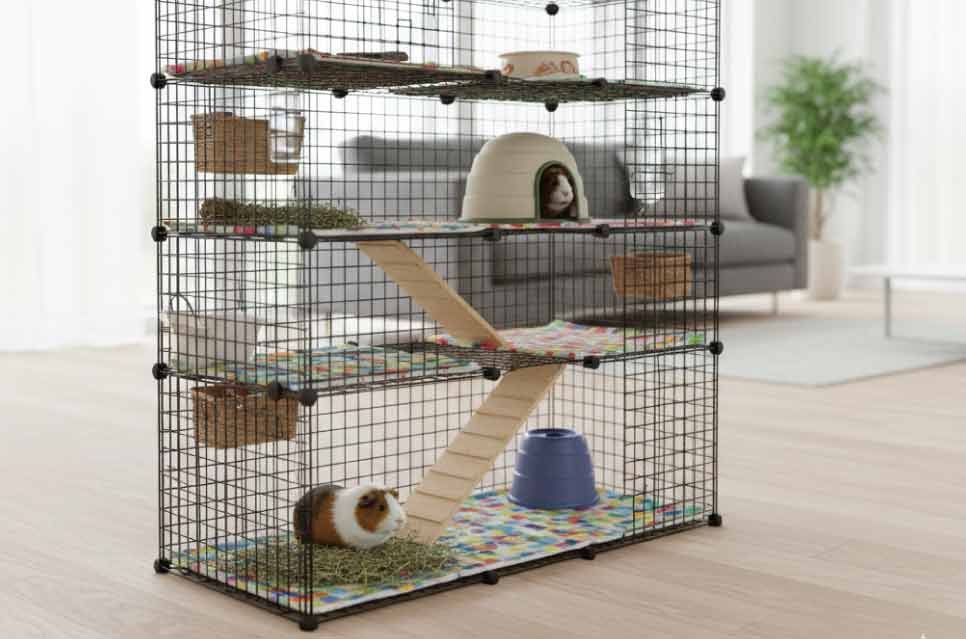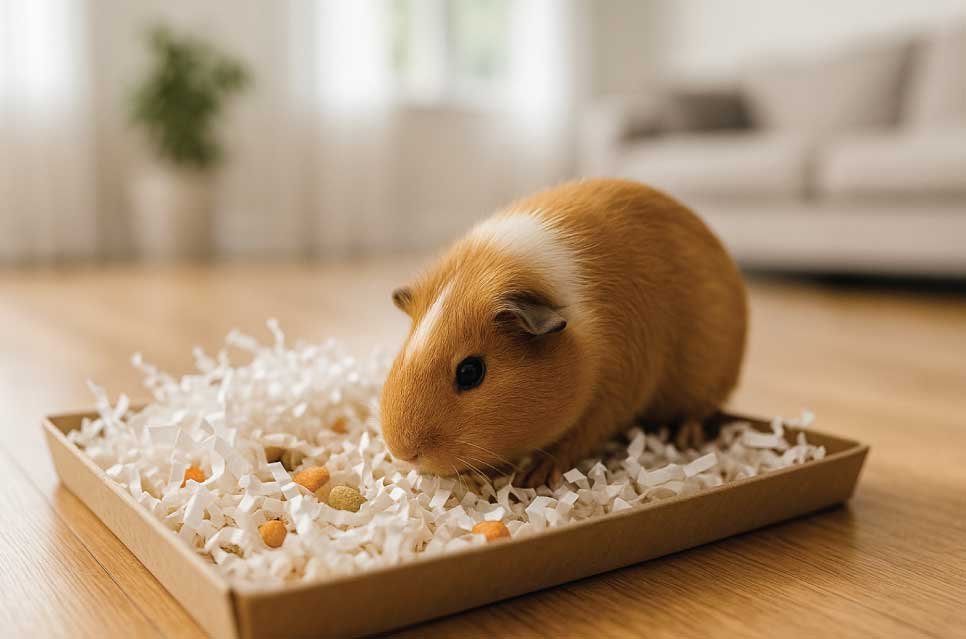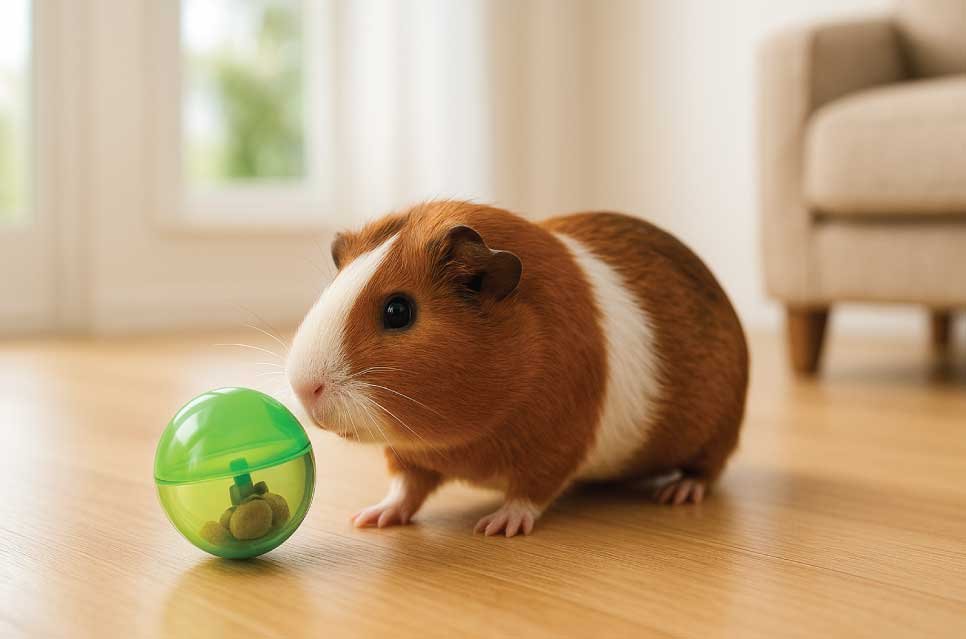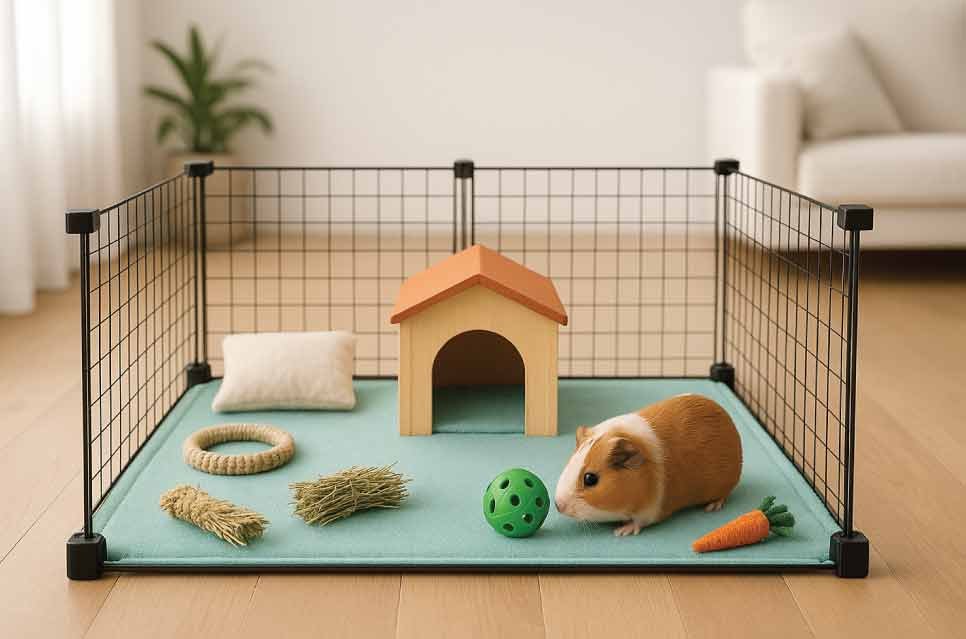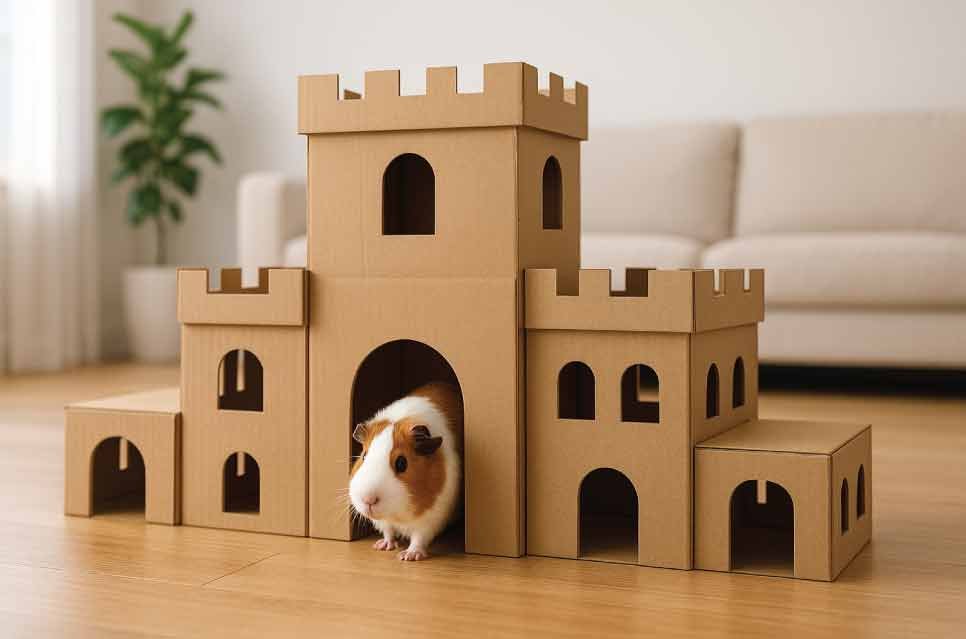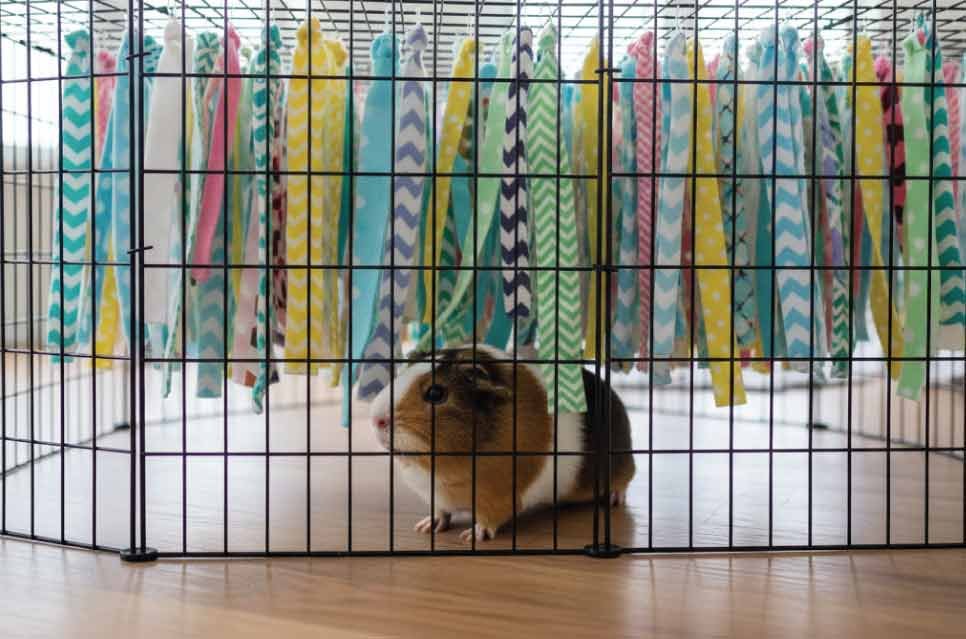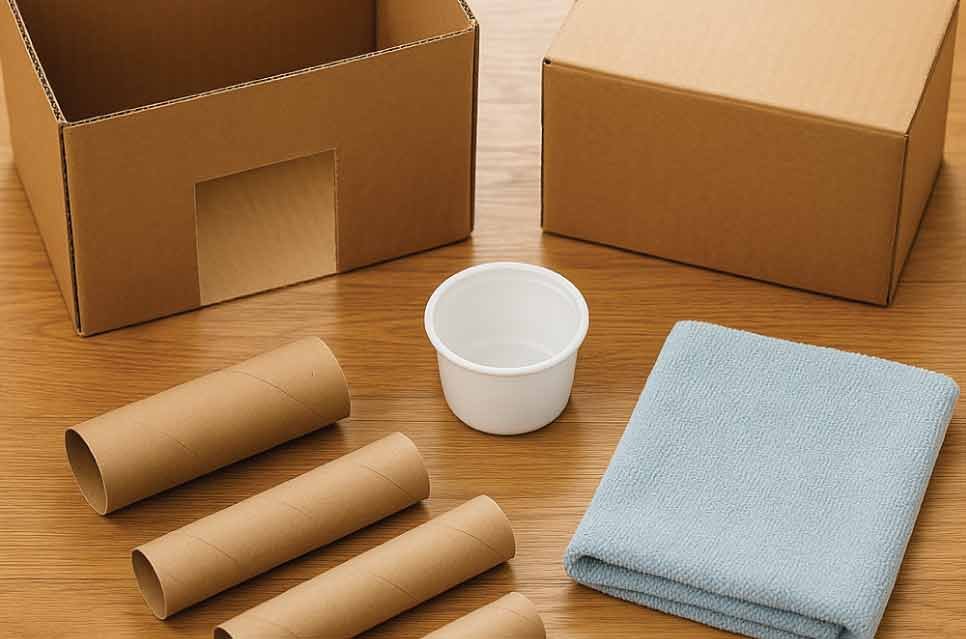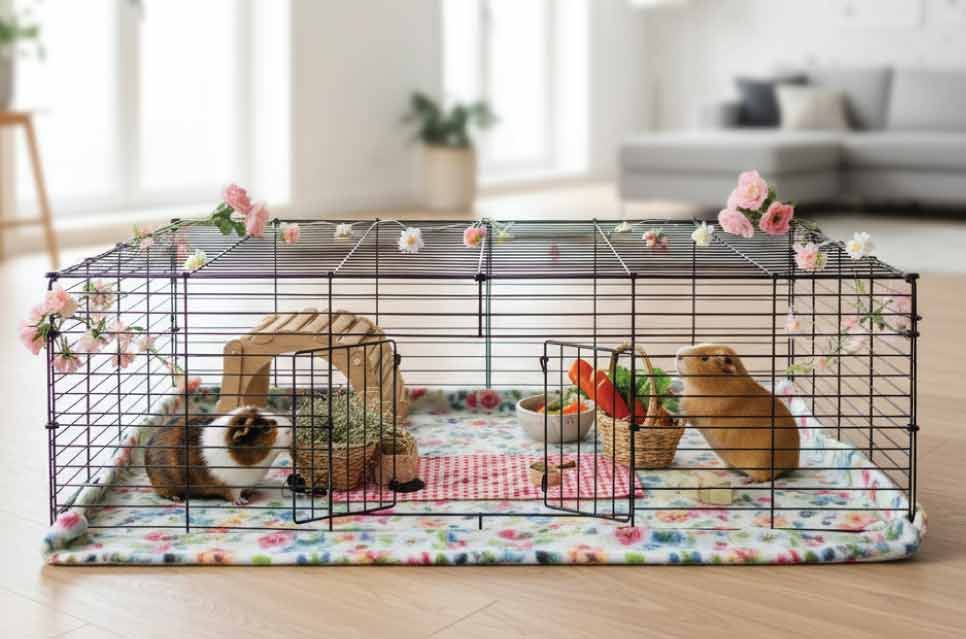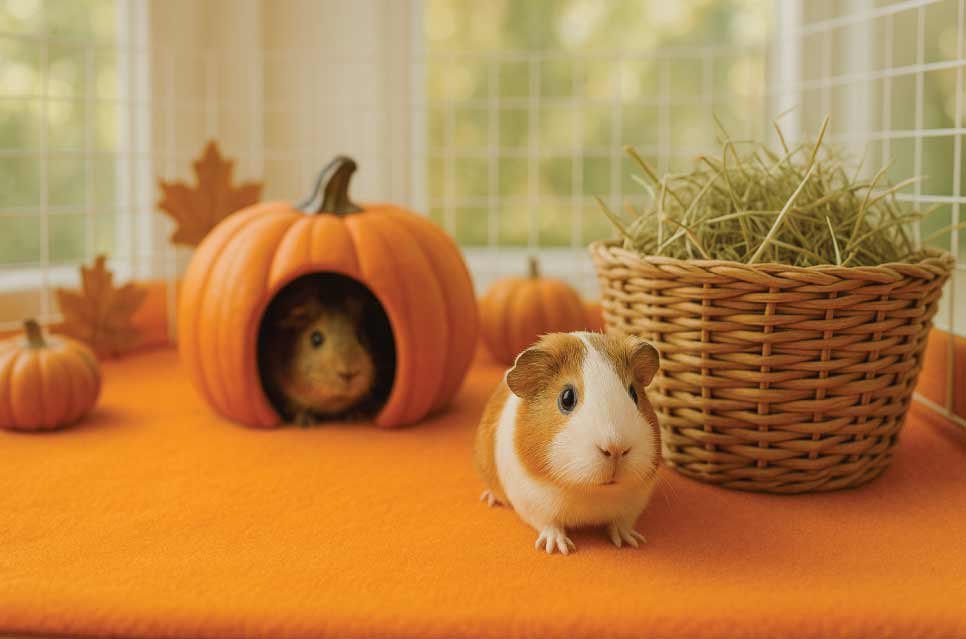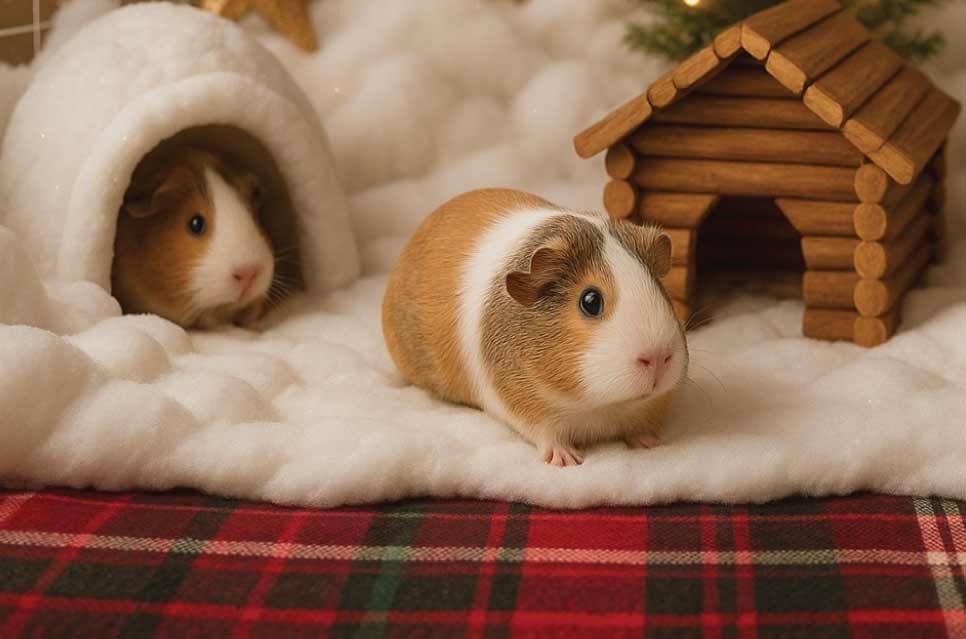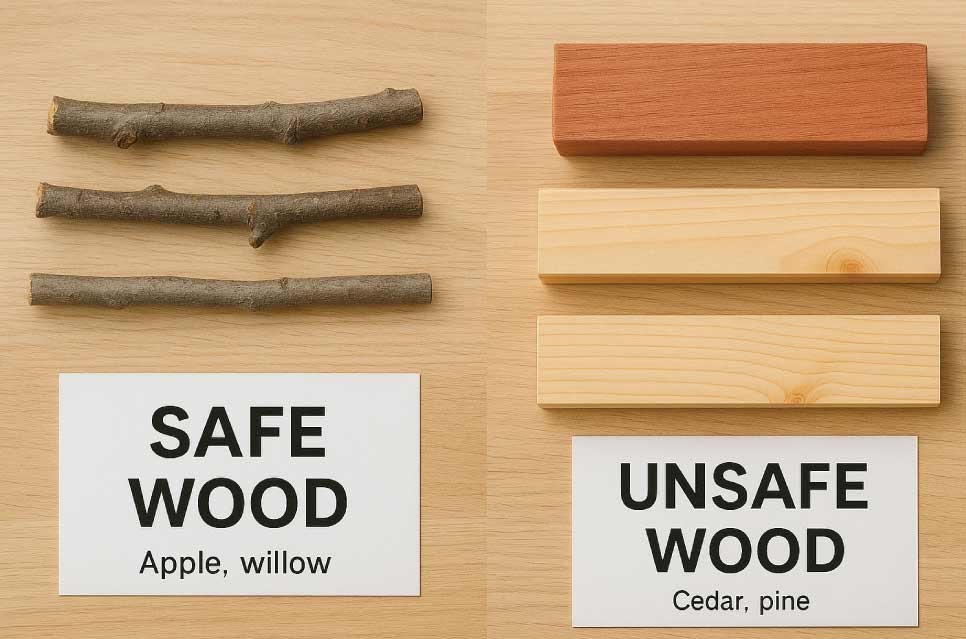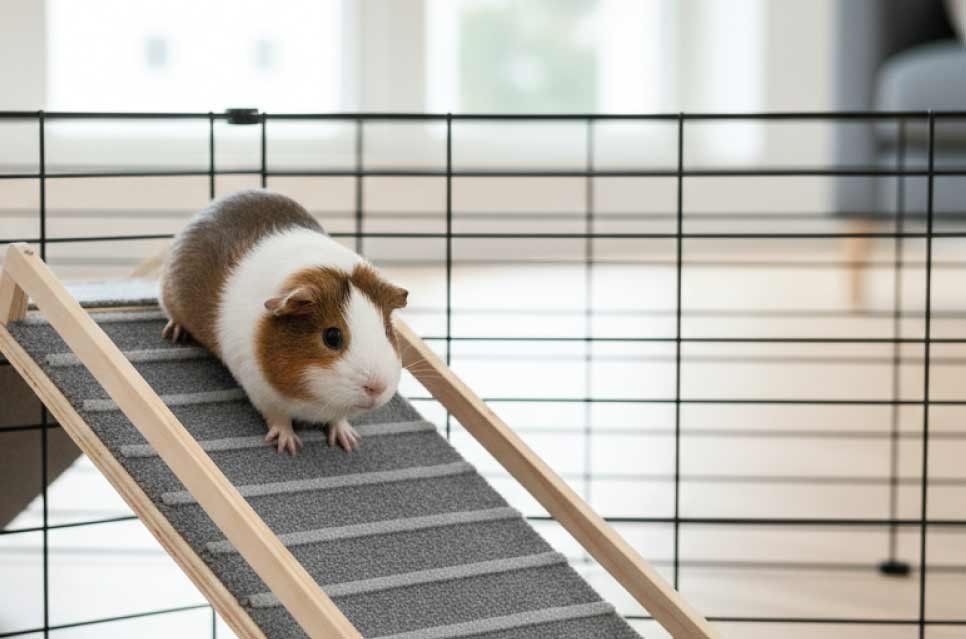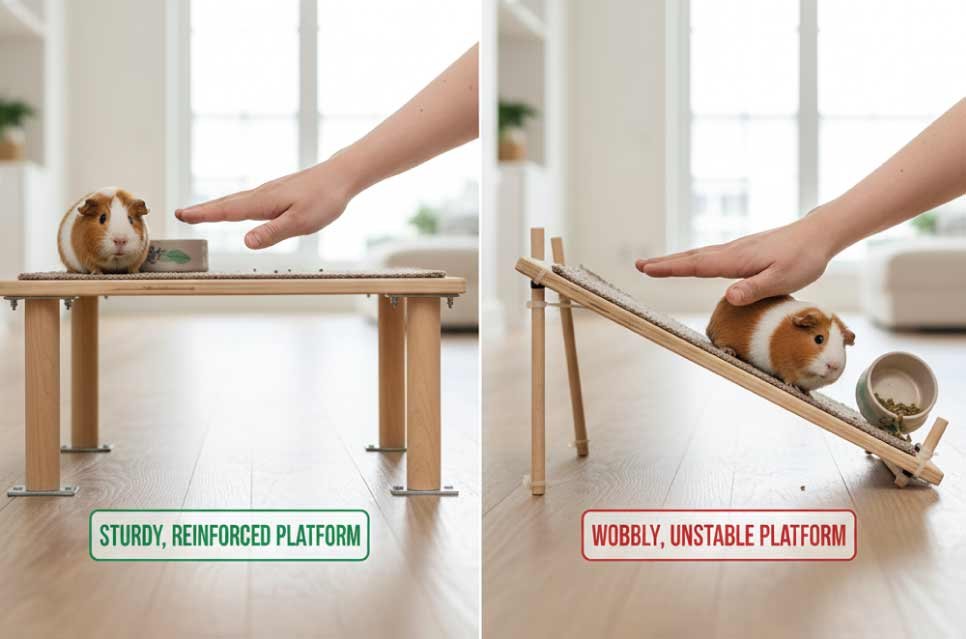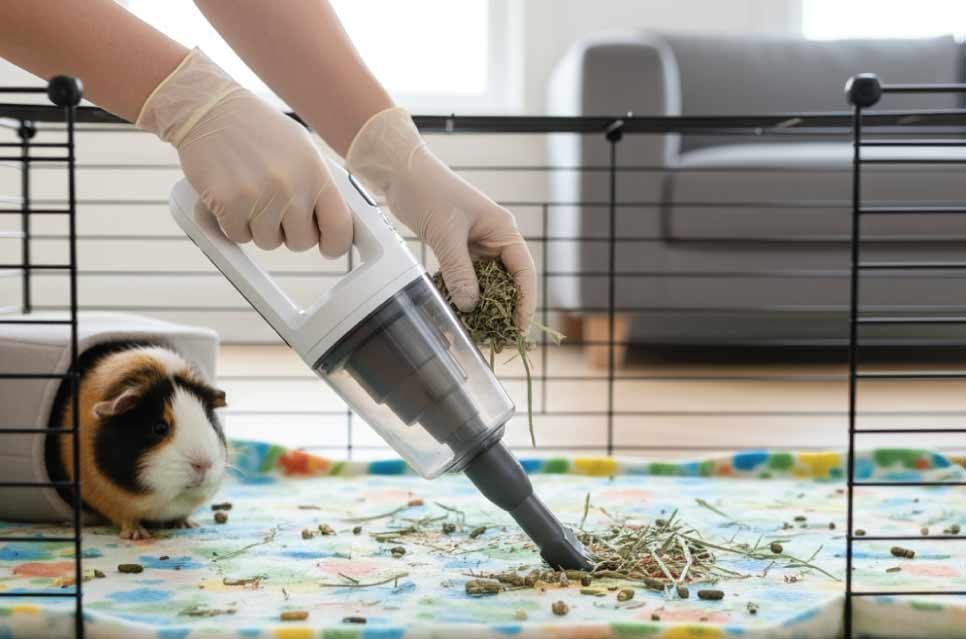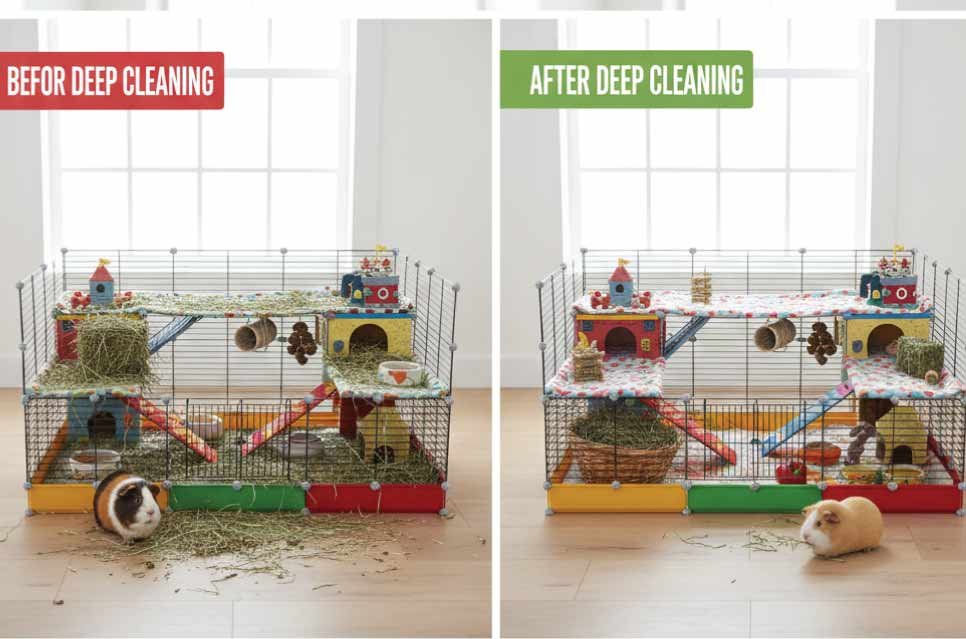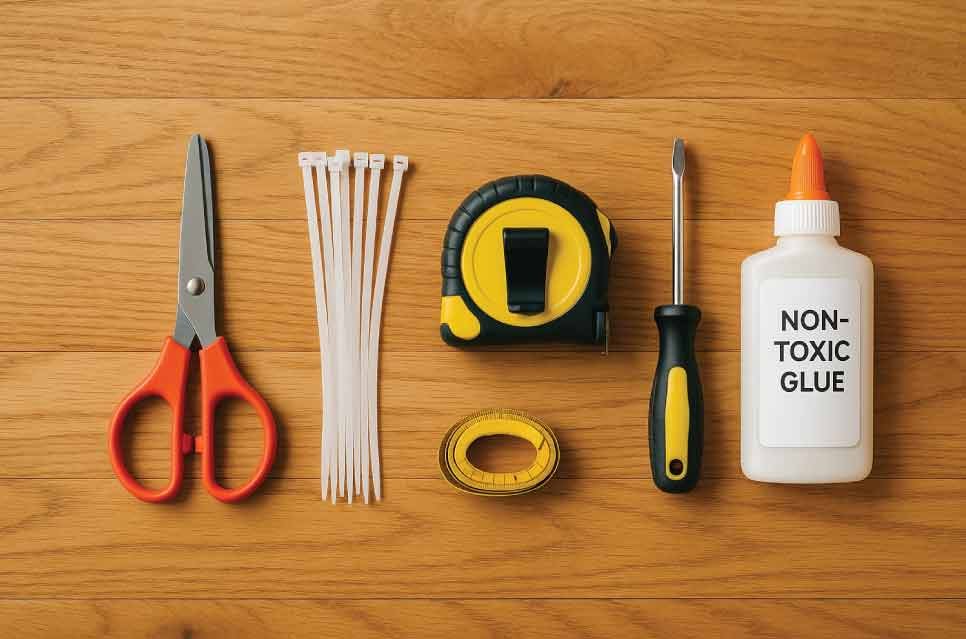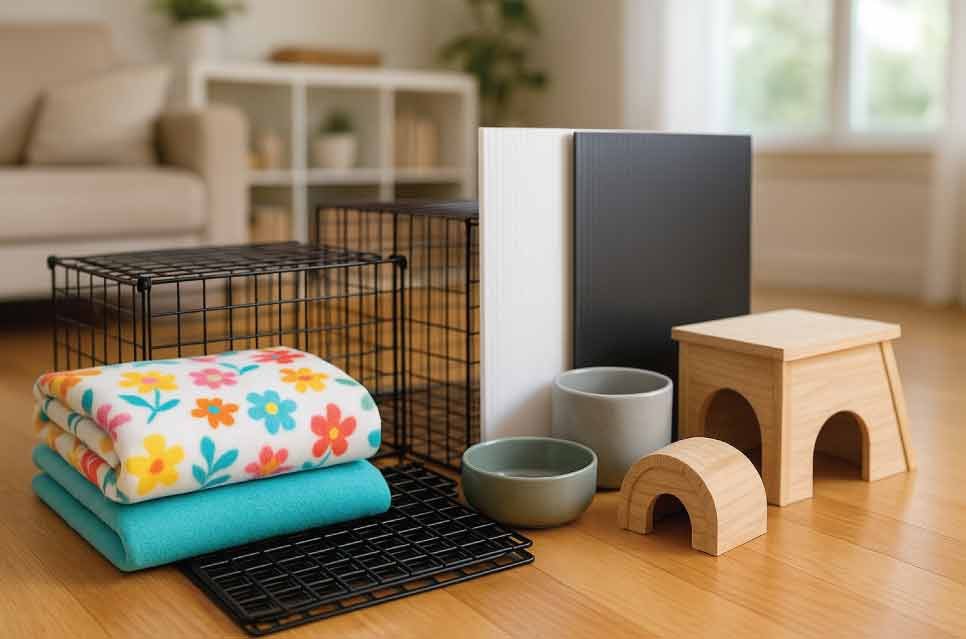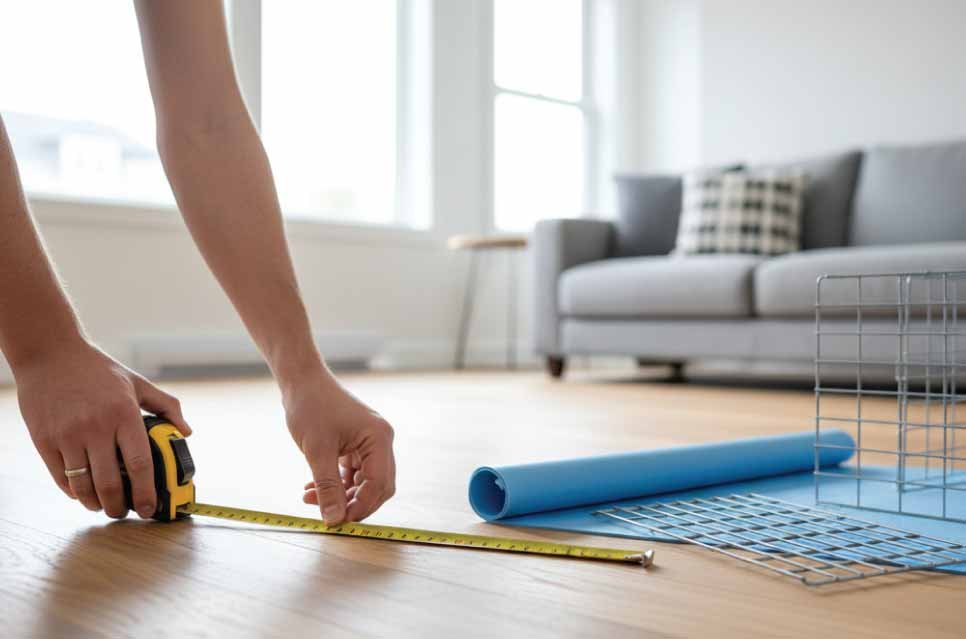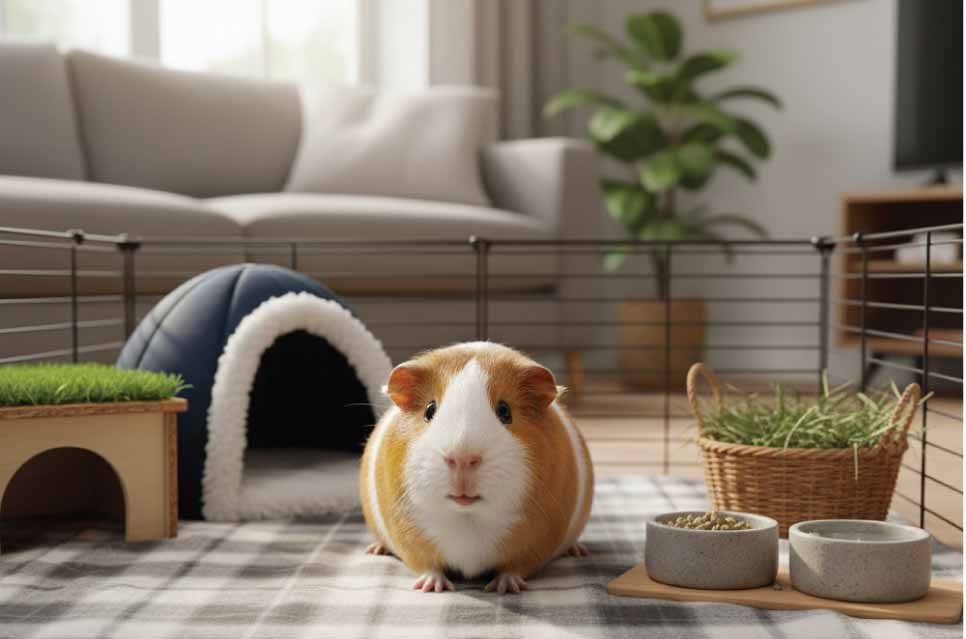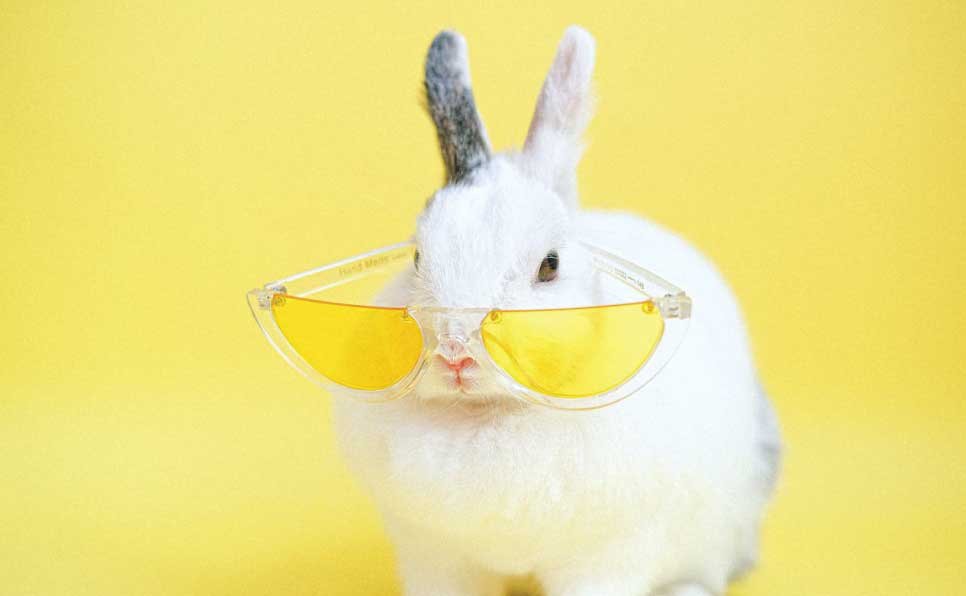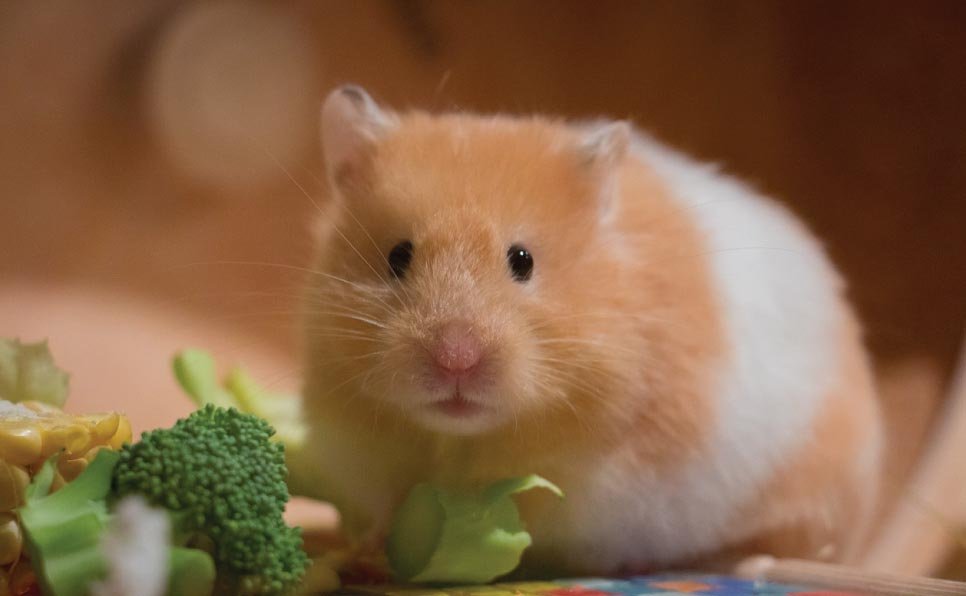At PetSweetJoy, we sometimes share products we truly love and use with our own pets. This post contains affiliate links, which means we may earn a small commission, at no extra cost to you. We only recommend products that fit our values of care, comfort, and responsible pet parenting.💗
Picture this: you walk into a room and instead of seeing a standard wire cage in the corner, you discover a multi-story guinea pig mansion complete with ramps, cozy hideaways, and play areas that would make any pet envious. That basic cage transformation? It’s not just a dream, it’s completely achievable with the right ideas and a little creativity.
Your guinea pig spends most of their day in their cage, so why not make it an extraordinary place they’ll love to call home? For more details on cage size, layout, and safe materials, you can also check the RSPCA Guinea Pig Housing Guide for professional welfare recommendations. Whether you’re working with a tight budget, limited space, or simply want to spoil your furry friend, the perfect cage design is waiting for you to discover it.
In this guide, you’ll discover 8 detailed cage design ideas that you can start implementing today. From budget-friendly DIY solutions using household items to elaborate multi-level adventures, each design comes with complete materials lists, step-by-step instructions, cost estimates, and safety guidelines. Whether you’re a crafty DIY enthusiast or prefer simple modifications, there’s a perfect project here that matches your skill level and your guinea pig’s personality.
Listen to the Podcast: Unique Guinea Pig Cage Ideas
1. The Multi-Story Mansion
Overview: Creating connected levels for maximum space utilization
Transform your guinea pig’s living space into a luxurious high-rise apartment that maximizes both floor space and vertical territory. This design is perfect for active guinea pigs who love to explore and provides separate zones for eating, sleeping, and playing, just like a real home!
Materials Needed:
- 14-16 C&C cage grids and connectors
- 2-3 Coroplast sheets (24″ x 36″)
- Heavy-duty cable ties (at least 50)
- Ramp materials: wooden boards (1″ x 6″ x 12″) or plastic shelving
- Non-slip ramp covering (carpet strips or textured tape)
- Small hinges for removable sections (optional)
Step-by-Step Instructions:
- Base Level Setup: Start by creating a sturdy foundation using 8-10 C&C grids to form a rectangular base measuring approximately 4′ x 2′. Cut your first Coroplast sheet to fit, creating 4-inch walls by scoring and folding. This ground floor will serve as your guinea pigs’ main living and dining area. Ensure all corners are securely connected with cable ties, pulling them tight but not over-tightening to avoid cracking the plastic.
- Adding the Second Tier: Position the second level about 12 inches above the base, using 4-6 additional grids to create a platform measuring roughly 2′ x 2′. This elevated space works perfectly as a cozy bedroom area. Cut a smaller piece of Coroplast for the floor, and remember to leave one side open for ramp access. Use cable ties to attach support posts, ensuring the structure can easily support your guinea pig’s weight plus any accessories.
- Creating the Third Tier (Optional): For the ultimate mansion experience, add a third level as a penthouse suite or observation deck. Keep this level smaller (about 1.5′ x 1.5′) and position it 10 inches above the second tier. This becomes an ideal spot for a special hideout or elevated food station.
- Building Safe, Gentle Ramps: Cut wooden boards or use plastic shelving to create ramps with a gentle incline (no steeper than 20 degrees). Cover each ramp with carpet strips or textured tape to prevent slipping. Secure ramps between levels using cable ties or small brackets. Make sure each ramp is at least 6 inches wide to accommodate your guinea pig comfortably, and test the stability before letting your pets use them.
- Connecting Levels Securely: Double-check all connections and give the structure a gentle shake test. Add extra cable ties at stress points, particularly where ramps attach to platforms. Consider creating removable sections using small hinges for easier cleaning access.
Cost Estimate: $80-120
Difficulty: Intermediate
Best For: Multiple guinea pigs, active pets
Pro Tips: Start with two levels and add the third once your guinea pigs are comfortable with the setup. Always supervise initial use to ensure your pets navigate the ramps safely, and consider adding small walls along ramp edges for extra security.
If you prefer a ready-made setup instead of building from scratch, the 2-Level Mansion Cage from Exotic Nutrition offers a secure and stylish alternative. Its solid metal frame, plexiglass guards, and multiple ramps create a spacious, chew-proof home that perfectly matches the multi-level mansion design.
2. The Garden Paradise Theme
Overview: Nature-inspired setup with safe plants and natural elements
Bring the tranquility of an English garden indoors with this charming nature-themed design. Your guinea pigs will feel like they’re living in their own private botanical paradise, complete with natural textures, garden-inspired hideouts, and carefully selected plant elements that stimulate their senses while keeping them safe.
Materials Needed:
- 3-4 artificial guinea pig-safe plants (spider plant, Boston fern replicas)
- 2-3 natural wood hideouts (untreated apple or willow wood)
- Stone-textured ceramic food and water bowls
- Grass-like bedding mats or artificial turf sections
- Small decorative logs (kiln-dried, pesticide-free)
- Natural woven baskets for hay storage
- Decorative stones (large enough to prevent choking hazards)
Design Elements:
- Creating Garden Zones: Divide your cage into distinct “garden rooms” using natural wood barriers or decorative logs. Create a “meadow” area with grass-like mats where your guinea pigs can graze and relax. Establish a “woodland” corner with natural hideouts and logs for exploration. Design a “dining terrace” using stone-textured bowls placed on a slightly elevated wooden platform.
- Safe Plant Placement: Position artificial plants strategically around the cage perimeter, ensuring they’re securely anchored and won’t tip over. Choose plants with soft, flexible leaves that won’t scratch if your guinea pigs brush against them. Avoid plants with small detachable parts that could become choking hazards.
- Natural Hiding Spots: Arrange wooden hideouts to create cozy cave-like retreats throughout your garden theme. Position them under “trees” (artificial plants) or behind decorative logs to enhance the natural forest feel. Ensure all hideouts have smooth, rounded entrances and are large enough for your guinea pig to turn around comfortably inside.
- Water Feature (Shallow Dish Decoration): Create a charming “pond” effect using a shallow, wide ceramic dish filled with large, smooth river stones and fresh water. This serves as both a functional water source and an attractive centerpiece. The stones prevent spillage while adding authentic garden ambiance.
Cost Estimate: $60-90
Difficulty: Beginner
Safety Note – Guinea Pig Safe Plants vs. Toxic: SAFE (if using real plants): Spider plants, Boston ferns, African violets, snapdragons, sunflowers TOXIC – NEVER USE: Lily of the valley, foxglove, daffodils, tulips, azaleas, ivy, oleander Recommendation: For safety, stick with high-quality artificial plants that look realistic but eliminate any risk of toxicity or digestive issues.
Add a touch of natural beauty with the Dandelion Delicacy treat mix, made from dried dandelion greens rich in minerals and vitamins. It not only fits the garden theme but also supports your guinea pig’s digestion and adds healthy variety to their diet.
3. The Adventure Playground
Overview: Activity-focused design with tunnels, bridges, and climbing areas
Transform your guinea pig’s home into an action-packed adventure course that challenges their natural instincts to explore, climb, and investigate. This dynamic setup keeps active guinea pigs mentally stimulated and physically engaged while providing endless entertainment for both pets and their human families.
Materials Needed:
- 6-8 PVC pipe sections (4-6 inch diameter, various lengths)
- PVC connectors (elbows, T-joints, straight connectors)
- 3-4 wooden planks (1″ x 4″ x 12-18″ untreated pine or poplar)
- Guinea pig-safe rope (cotton or hemp, ¼ inch thick)
- 5-6 various sized cardboard boxes (shoe boxes to medium moving boxes)
- Non-slip mats or textured tape
- Small wooden dowels for support posts
- Cable ties and small screws for connections
Construction Guide:
- Building Tunnel Systems: Create an interconnected network using PVC pipes cut to 12-18 inch lengths. Connect sections with elbow joints to form L-shapes and T-joints for three-way intersections. Ensure all tunnel openings are at least 5 inches in diameter, your guinea pig should never feel squeezed. Sand any rough edges smooth and test-fit all connections before final assembly. Create multiple entry and exit points to prevent your guinea pig from feeling trapped and to encourage exploration.
- Creating Elevated Walkways: Build sturdy bridges using wooden planks supported by small posts every 8-10 inches. Position bridges 4-6 inches above ground level, high enough to be interesting but low enough to be safe if your guinea pig falls. Wrap support posts with guinea pig-safe rope for texture and grip. Add railings along bridge edges using thin wooden dowels connected with rope, creating a secure pathway that prevents accidental tumbles.
- Making Climbing Ramps: Construct textured climbing surfaces by wrapping wooden planks with rope in a spiral pattern, or attach non-slip mats with pet-safe adhesive. Create ramps with gentle inclines (15-20 degrees maximum) that connect ground level to elevated platforms. Install small wooden cleats every few inches to provide extra grip and confidence for nervous climbers.
- Designing Activity Zones: Establish distinct areas throughout the playground: a “cardboard castle” made from connected boxes with cut-out doorways and windows, a “tunnel junction” where multiple PVC pipes meet, and an “observation deck” (elevated platform) for surveying their domain. Each zone should offer different types of stimulation, hiding, climbing, exploring, or resting.
- Interactive Elements: Integrate treat-dispensing toys throughout the course by attaching puzzle feeders to bridge posts or tunnel entrances. Hang timothy hay in small mesh bags at various heights to encourage reaching and stretching. Create “treasure hunts” by hiding healthy treats in different zones, encouraging your guinea pig to explore the entire playground.
- Encourage curiosity and movement with the Rolling Forage Cylinder. This clever foraging toy dispenses small treats as your guinea pig nudges or rolls it, turning playtime into a fun and rewarding mental challenge.
Cost Estimate: $70-110
Difficulty: Intermediate-Advanced
Safety Reminders: Test all structures with gentle pressure before allowing use. Avoid gaps wider than 1 inch where little paws could get stuck. Replace cardboard elements monthly or when they show wear, and inspect rope wrapping regularly for fraying.
4. The Cozy Cottage Setup
Overview: Multiple themed hideaways and comfort zones
Create the ultimate comfort haven that feels like a miniature home, complete with designated rooms for different activities. This design is perfect for guinea pigs who prefer cozy, secure spaces over high-energy adventures, providing them with multiple retreat options throughout their day.
Materials Needed:
- 3-4 igloos or houses in different sizes (plastic, wood, or fleece)
- Premium soft fleece bedding in coordinating colors
- Small decorative cushions or pillows (guinea pig-safe fabrics)
- Multiple ceramic food bowls and water bottles
- Soft fabric tunnels or fleece forests
- Small area rugs or fleece squares for each “room”
- Wicker baskets for hay and toy storage
Design Features:
- Master Bedroom Area: Position the largest, most comfortable igloo in a quiet corner as the primary sleeping quarters. Line it with extra-soft fleece and add a small cushion for ultimate luxury.
- For an extra-comfortable retreat, try the Cozy Cube, a soft, double-layered fleece hideout with a removable pillow. It keeps your guinea pig warm in winter and cool in summer, ideal for creating the “bedroom” corner of your cozy cottage layout.Place this “bedroom” away from high-traffic areas and food stations to create a true sanctuary for rest and relaxation.
- Dining Room Setup: Establish a dedicated eating area using a coordinating food bowl set on a small area rug or fleece mat. Position the hay rack nearby and ensure easy access to fresh water. Keep this space separate from sleeping areas to maintain good hygiene and create distinct living zones that feel like a real home.
- Living Room with Toys: Create a central gathering space using a medium-sized hideout that can accommodate multiple guinea pigs. Arrange favorite toys, chew items, and a small tunnel entrance nearby. This becomes the social hub where guinea pigs can interact, play, and observe their surroundings while still feeling secure.
- Bathroom Corner (Litter Area): Designate one corner with appropriate litter material and position it away from food and sleeping areas. Many guinea pigs naturally choose specific spots for their bathroom needs, so observe their preferences and place this “room” accordingly. Use a different colored fleece to clearly define this functional space.
- Comfort Enhancements: Add soft lighting effects with strategically placed hideouts that create cozy shadows. Use different textures throughout, smooth ceramics for dining, plush fleece for sleeping, and woven materials for play areas. This variety stimulates their senses while maintaining the overall comfort theme.
Cost Estimate: $50-80
Difficulty: Beginner
Perfect For: Shy or anxious guinea pigs, elderly pets, or those recovering from illness
Bonus Tip: Rotate cushions and small decorative elements weekly to keep the environment fresh and interesting while maintaining the same comforting layout your guinea pig has learned to love.
5. The Vertical Village
Overview: Maximizing small spaces with smart vertical design
When floor space is at a premium but your guinea pig deserves a spacious home, think upward! This ingenious vertical design creates multiple living levels within a compact footprint, perfect for apartment dwellers who refuse to compromise on their pet’s quality of life.
Materials Needed:
- Tall cage framework (minimum 36″ height) or stackable C&C sections
- 4-6 sturdy platforms (wood or reinforced plastic shelving)
- Heavy-duty support posts (metal or thick wooden dowels)
- Non-slip ramp covers (textured mats or carpet strips)
- Wall-mounting brackets and hardware
- Cable management clips for organization
- Stackable plastic storage containers (modified for hideouts)
- Construction Strategy: Build this vertical village in sections, starting with a solid base level and gradually adding upper “neighborhoods.” Each level should be fully functional on its own, allowing you to test stability and guinea pig comfort before expanding upward. Use reinforced support posts at every corner and mid-span to ensure the structure can safely handle multiple guinea pigs moving simultaneously.
Space-Saving Features:
- Wall-Mounted Accessories: Transform your cage walls into functional storage by mounting hay feeders, water bottles, and toy holders directly to the grid walls. Use suction cup organizers or wire baskets to keep supplies accessible but off precious platform space.
- To make the most of vertical space, the Apple Stick Hay Feeder combines fun and functionality. It encourages natural foraging behavior while keeping hay neatly organized and within reach on upper levels. Position these accessories at guinea pig eye-level for easy access without requiring climbing.
- Hanging Hay Feeders: Suspend hay nets or feeders between levels to create “snacking stations” throughout the village. This not only saves floor space but encourages natural foraging behavior as guinea pigs stretch and reach for their favorite timothy hay. Use adjustable chains or rope to modify heights as needed.
- Stackable Hideouts: Choose modular hideouts that nest together when not in use and can be rearranged to create different configurations. Lightweight plastic igloos work perfectly, as do fabric tunnels that can collapse flat for easy storage or cleaning. Create “high-rise apartments” by stacking these vertically with secure connections.
- Corner Utilization: Don’t waste those awkward corner spaces! Install triangular corner platforms that provide cozy nooks perfect for single guinea pigs to retreat and observe their domain. These corners also work excellently for litter areas, keeping waste management discrete and space-efficient.
- Advanced Engineering: Install a pulley system for easy cleaning access to upper levels, or design removable platform sections that slide out for maintenance. Consider adding small elevators (secure boxes on guided tracks) for elderly or less mobile guinea pigs to access upper levels safely.
Cost Estimate: $90-130
Difficulty: Advanced
Ideal For: Apartment living, limited floor space, multiple guinea pig households
Planning Tip: Sketch your vertical village on paper first, measuring each level carefully to ensure ramps fit properly and no guinea pig will be trapped on an upper level without multiple exit routes.
6. The Activity & Enrichment Center
Overview: Interactive feeding and play stations
Transform mealtime from a mundane routine into an engaging adventure that stimulates your guinea pig’s natural instincts. This enrichment-focused design turns your pet into an active participant in their daily care, promoting both physical exercise and mental sharpness through purposeful play.
To keep your guinea pig mentally stimulated between play sessions, the Natural Fun Balls 6 Pack offers natural materials for rolling, tossing, and chewing, a simple way to encourage curiosity and prevent boredom.
Materials Needed:
- 3-4 puzzle feeders of varying difficulty levels
- Rolling treat balls with adjustable openings
- Shallow dig boxes or foraging trays
- Rotating toy stations (lazy Susan bases work perfectly)
- Timothy hay stuffed into paper tubes and bags
- Multiple small food dishes for scatter feeding
- Textured mats for different sensory experiences
- Small cardboard boxes for DIY puzzle creation
Enrichment Ideas:
- Foraging Opportunities: Create natural feeding experiences by hiding pellets and treats throughout the cage in paper bags, cardboard tubes, and shallow boxes filled with shredded paper. Scatter small portions of daily food rations in different locations, encouraging your guinea pig to “hunt” for their meals just as they would in the wild. This simple change can extend a 5-minute feeding session into 30 minutes of engaging activity.
- Mental Stimulation Zones: Establish different puzzle stations throughout the cage, each offering unique challenges. Start with simple treat-dispensing balls and gradually introduce more complex puzzle feeders that require pushing, rolling, or manipulating to access food. Rotate these puzzles weekly to prevent your guinea pig from becoming bored with familiar challenges.
- Physical Challenge Areas: Design obstacles that encourage natural movements like climbing over small hurdles, walking through hanging fabric strips, or navigating around movable objects. Create “workout stations” where guinea pigs must stretch, reach, or balance to access their favorite treats. These challenges should always be optional, never block access to essential resources like water or basic food.
- Comfort Retreats: Balance active areas with designated rest zones where your guinea pig can observe their enriched environment without pressure to participate. Position comfortable hideouts with good sightlines to the activity areas, allowing naturally curious guinea pigs to watch and learn before joining in.
- Interactive Feeding Stations: Replace traditional food bowls with engaging alternatives: hang hay nets at various heights, use muffin tins with treats in each cup, or create “salad bars” where fresh vegetables are presented in different textures and arrangements. These feeding modifications encourage natural grazing behaviors while adding variety to daily routines.
- Reward your guinea pig’s problem-solving with Fruit & Veggie Tarts small, fiber-rich treats made from Timothy hay, apples, and carrots. Hide them inside puzzle feeders or foraging boxes to make snack time both healthy and exciting.
Cost Estimate: $40-70
Difficulty: Beginner-Intermediate
Benefits: Prevents boredom, encourages natural behaviors, improves physical fitness, enhances problem-solving skills
Success Indicator: A well-enriched guinea pig will spend significantly more time actively exploring and engaging with their environment rather than just eating and sleeping.
7. The Budget-Friendly DIY Haven
Overview: Creative solutions using household items and affordable materials
Who says creating an amazing guinea pig paradise has to break the bank? This ingenious approach proves that the best cage accessories often come from your recycling bin and donation pile. With a little creativity and some basic crafting skills, you can build an engaging environment that rivals expensive store-bought setups.
Household Items to Repurpose:
- Cardboard Boxes: Save everything from cereal boxes to appliance packaging. Large boxes become multi-room hideouts, medium boxes transform into cozy bedrooms, and small boxes work perfectly as individual retreats or treat-dispensing puzzles.
- Plastic Storage Containers: Clean yogurt containers, takeout boxes, and storage tubs make excellent water dishes, dig boxes, and modular hideouts. Cut doorways in larger containers to create spacious igloos that cost pennies compared to pet store versions.
- Towels and Old T-Shirts: Worn-out linens become luxurious bedding when cut into appropriately sized pieces. T-shirts can be braided into climbing ropes or hung as privacy curtains between cage sections.
- Paper Bags and Tubes: Grocery bags, toilet paper rolls, and wrapping paper tubes create instant foraging opportunities. Fill them with hay or hide treats inside for engaging puzzle feeders that cost nothing but provide hours of entertainment.
DIY Projects:
- Cardboard Castle: Connect multiple boxes of varying sizes using non-toxic tape or staples placed safely out of reach. Cut archways, windows, and doorways to create an elaborate fortress. Replace sections as they wear out, your guinea pig will enjoy exploring the “renovations!”
- Fleece Forest (Hanging Strips): Cut old fleece blankets into 2-inch wide strips and hang them from the cage ceiling at varying heights. This creates a sensory wonderland where guinea pigs can hide, brush against different textures, and feel secure while still being able to see through the “forest.”
- Box Maze System: Create an ever-changing labyrinth using various sized boxes with cut-out doorways. Tape boxes together temporarily, allowing you to reconfigure the maze weekly. This keeps the environment fresh and challenging without ongoing costs.
- Homemade Climbing Structures: Build ramps and platforms using sturdy cardboard reinforced with tape, or repurpose wooden cutting boards and books as elevated platforms. Cover surfaces with towels for traction and comfort.
- Even if you’re going for an affordable DIY setup, enrichment doesn’t have to be boring. The Chew Stick Value Pack includes apple, plum, and willow sticks that satisfy your guinea pig’s natural chewing instincts while promoting good dental health.
Cost Estimate: $20-40
Difficulty: Beginner
Eco-Friendly Benefits: This approach reduces household waste while creating enriching environments. Most materials can be composted or recycled when worn out, making it a sustainable choice for environmentally conscious pet owners who want to minimize their ecological pawprint.
8. The Seasonal Themed Cage
Overview: Rotating decorations and setups for year-round variety
Why stick to one look all year when you can keep your guinea pig’s home as dynamic as the changing seasons? A seasonal theme cage adds fun variety for both you and your pet by refreshing the environment with new colors, textures, and accessories every few months. This not only keeps your guinea pig’s surroundings visually engaging but also gives you the chance to get creative with budget-friendly décor that matches the season.
Spring & Summer Themes:
- Beach Paradise: Use light-colored fleece liners, seashell-patterned fabric hideouts, and smooth river stones (too large to swallow) to mimic a sandy shoreline. Add a shallow dig box filled with shredded paper for “sand play.”
- Garden Party: Bright floral fleece patterns, artificial flowers (securely anchored), and picnic-style checkered mats bring the cheer of outdoor gatherings indoors.
- Camping Adventure: Create a “tent” hideout with fabric draped over small rods, add faux mini campfires made from felt, and arrange log-shaped hideouts for that outdoor vibe.
Fall & Winter Themes:
- Cozy Cabin: Plaid fleece bedding, wooden hideouts, and soft pillows set the tone for a warm retreat. Use darker, earthy tones for comfort.
- Winter Wonderland: White fleece liners, cotton batting “snow drifts,” and igloo-style hideouts create a magical, frosty scene. Sparkle-effect safe decorations add charm without risk.
- Harvest Festival: Orange and brown fleece liners, pumpkin-shaped hideouts (ceramic or fabric), and woven baskets filled with hay bring the feeling of autumn indoors.
Implementation Tips:
The key to seasonal setups is flexibility. Use changeable decorative elements such as fleece liners, hideout covers, and toy rotations. Stick to season-appropriate colors and keep a small storage bin for each theme so switching between them is quick and fun.
For a lovely seasonal accent, the Flower Fusion Treat a blend of rose, hibiscus, and calendula, fits perfectly into spring or summer themes. These colorful dried flowers not only look beautiful but are high in fiber and safe for guinea pigs to nibble.
Cost Estimate: $30–60 per season
Difficulty: Beginner
Pro Tip: While decorations can be fun, always prioritize safety. Avoid small detachable parts, glitter, or anything your guinea pig could chew and swallow. With thoughtful seasonal updates, you’ll create a cage that’s fresh, festive, and endlessly engaging all year long.
Essential Safety Guidelines
No matter how creative or elaborate your guinea pig’s cage design becomes, safety should always be the foundation. A beautiful setup isn’t worth the risk if it puts your furry friend in danger. These guidelines will help you keep every project safe, functional, and worry-free.
Materials to Avoid:
Steer clear of toxic woods such as cedar, raw pine, and oak, which release harmful oils or fumes. Skip painted or varnished items unless they’re specifically marked as pet-safe. Avoid anything with sharp edges, staples, or loose threads that could cause injury or choking.
Safe Openings and Ramps:
Openings should be wide enough for your guinea pig to move through comfortably (at least 5 inches across). Ramps should never exceed a 20-degree incline, with non-slip surfaces like carpet strips or textured mats to prevent accidents. Always add small guardrails to protect from falls.
Weight Limits for Elevated Structures:
Platforms and upper levels must be sturdy enough to hold at least double your guinea pig’s weight plus accessories. Test by pressing down firmly, if it wobbles, reinforce it before use.
Routine Safety Inspections:
Check cages weekly for loose ties, frayed fabrics, or chewed areas that could create hazards. Replace worn-out elements immediately to prevent accidents.
Emergency Considerations:
Keep your guinea pig’s habitat in an accessible location for quick removal in case of fire, flooding, or sudden illness. Having a pet carrier nearby ensures you’re always ready to act.
By making safety your top priority, you can confidently explore creative designs while ensuring your guinea pig enjoys their home in comfort and security.
Quick Safety Checklist for Guinea Pig Cages
✅ Materials
- Avoid cedar, raw pine, and oak woods. If you’d like a more complete reference list, the Guinea Pig guide to safe woods provides detailed information on which materials are safe or unsafe for guinea pigs.
- Skip painted/varnished items (unless pet-safe)
- No sharp edges, staples, or loose threads
✅ Openings & Ramps
- Openings at least 5 inches wide
- Ramps ≤ 20° incline with non-slip surface
- Add small guardrails on ramps and platforms
✅ Elevated Structures
- Platforms must hold at least 2x guinea pig’s weight + accessories
- Test by pressing firmly, reinforce if wobbly
✅ Regular Inspections
- Weekly check for loose ties, frayed fabrics, or chewed areas
- Replace or repair worn-out parts immediately
✅ Emergency Prep
- Keep cage in an accessible location
- Have a pet carrier ready for quick evacuations
- Respiratory Health: Guinea pigs have sensitive respiratory systems, making them prone to respiratory infections like pneumonia and URIs. Proper ventilation helps to circulate fresh air, diluting harmful gases and reducing the risk of these infections.
- Body Temperature Regulation: Guinea pigs are prone to overheating due to their thick fur and lack of sweat glands. Proper ventilation allows for heat to escape, preventing heatstroke and maintaining their body temperature within a comfortable range.
- Ammonia Fumes Control: Guinea pig urine and feces produce ammonia, which can accumulate in a poorly ventilated cage, causing respiratory irritation and discomfort. Adequate airflow helps to remove these fumes, keeping the cage environment fresh and healthy.
Maintenance & Cleaning Tips
Keeping your guinea pig’s home fresh and hygienic is just as important as making it creative. A smart design makes cleaning easier and keeps your pet healthier. Choose easy-to-clean materials like Coroplast flooring, fleece liners with absorbent layers, and ceramic bowls that can be quickly washed. Avoid porous wood or fabrics that trap odors.
- Weekly Maintenance Routine: Spot-clean daily by removing soiled bedding and refreshing water. Once a week, replace all bedding, wipe down cage walls, wash bowls, and sanitize water bottles. Rotate toys and accessories to keep the environment engaging while ensuring nothing is worn out or unsafe.
- Deep Cleaning Schedule: Once a month, take everything out for a full scrub. Wash liners thoroughly, disinfect plastic or metal surfaces with pet-safe cleaners, and rinse well. Dry completely before reassembly.
- Replacing Worn Elements: Fabrics, chews, and cardboard hideouts naturally wear down. Replace them before they become unsafe. Rotating fresh items not only keeps your guinea pig safe but also makes their environment feel new and exciting.
Tools & Supplies Shopping List
To create and maintain an extraordinary guinea pig cage, having the right tools makes the job easier and more cost-effective.
Essential Tools: Cable ties, scissors, box cutters, measuring tape, non-toxic glue or tape, and small screwdrivers for assembly. For cleaning, keep a handheld vacuum, pet-safe disinfectant, and spare fleece liners on hand.
Where to Buy Materials: Big-box stores (for Coroplast, grids, fleece), local hardware shops (for ramps, screws, rope), and online retailers or guinea pig specialty shops for hideouts and enrichment items. Many supplies can also be found secondhand, thrift stores are goldmines for fleece blankets and baskets.
Money-Saving Tips: Buy fleece in bulk or during seasonal sales, and repurpose safe household items like cardboard boxes or old towels. Creating DIY elements often costs a fraction of store-bought versions.
Quality vs. Budget: Some items, like sturdy ramps, secure grids, and water bottles, are worth paying more for long-term durability. Save money on temporary or frequently replaced elements such as cardboard tunnels and fabric toys.
Before You Start Checklist
Before diving into your guinea pig cage makeover, take a little time to plan:
- Measure Your Space: Know the exact dimensions of the area where the cage will go.
- Assess Your Guinea Pig’s Personality: Active explorers need ramps and tunnels, while shy pigs prefer cozy hideouts and low-stress layouts.
- Budget Planning: Decide how much you’re comfortable spending per project or season. Creative DIY hacks can stretch your budget without sacrificing fun.
- Time Requirements: Some builds take an afternoon, while others may span a weekend. Match your project to the time you realistically have.
Safe Ways to Enhance Ventilation in Guinea Pig Cage
- Wire Mesh Cage Top: Opt for a cage with a wire mesh top instead of a solid one. This allows for unrestricted airflow and prevents buildup of harmful gases.
- Regular Cage Cleaning: Clean the cage thoroughly at least once a week to remove accumulated urine and feces, reducing the ammonia concentration in the air.
- Position the Cage Properly: Avoid placing the cage in direct sunlight, near heating vents, or in enclosed spaces with limited air circulation.
- Avoid Overcrowding: Overcrowding can increase the concentration of ammonia and reduce air circulation, making ventilation even more important.
- Use Natural Bedding: Choose a natural bedding material like Timothy hay or kiln-dried aspen shavings, which are less dusty and produce less ammonia than cedar or pine shavings.
- Moderate Temperature: Maintain a comfortable temperature range of 65-75 degrees Fahrenheit in the guinea pig’s environment. Avoid extreme temperatures that can affect their respiratory health.
- Provide Fresh Water: Always provide fresh, clean water for your guinea pigs to drink. Dehydration can worsen respiratory conditions and overall health.
- Monitor for Signs of Illness: Watch for signs of respiratory distress, such as sneezing, coughing, difficulty breathing, or lethargy. If you notice any of these symptoms, consult with your veterinarian promptly.
By following these simple steps, you can ensure that your Guinea Pig cage has adequate ventilation, promoting their respiratory health, well-being, and overall quality of life.
Guinea Pig's cage: Frequently Asked Questions (FAQs)
Guinea pigs are sensitive to temperature changes and drafts, so outdoor housing is generally not recommended. If you do keep them outside, the enclosure must be predator-proof, weather-protected, and within a safe temperature range (65–75°F / 18–24°C).
Guinea pigs are social animals and do best in pairs or small groups. The key is providing enough space, add 2–4 extra square feet per additional guinea pig to prevent crowding or territorial behavior.
Solid, non-wire flooring is essential to protect sensitive feet. Popular options include Coroplast bases, fleece liners with absorbent layers, or paper-based bedding. Avoid bare wire bottoms, which can cause injuries.
Rotating toys weekly helps prevent boredom and encourages natural curiosity. Simple changes, like moving hideouts, swapping tunnels, or introducing new textures, keep your guinea pig engaged without overwhelming them.
Yes, items like fleece blankets, baskets, or storage grids are excellent budget-friendly finds. Just make sure all materials are non-toxic, easy to clean, and free of sharp edges or residues before introducing them into the cage.
Introduce them in a neutral playpen first to avoid territorial disputes. Once they bond, move them into the main cage, ideally after rearranging the layout so it feels like “new” territory for all pigs.
Conclusion
Creating a unique guinea pig cage is more than a fun DIY project, it’s a way to enrich your pet’s daily life. With thoughtful planning, safe materials, and a bit of creativity, you can transform a plain setup into a multi-level mansion, a themed paradise, or even a seasonal wonderland.
The best part? You don’t have to do it all at once. Start with one idea that excites you, test how your guinea pig responds, and expand over time. Every addition, no matter how small, contributes to a happier and healthier pet.
We’d love to see your creations! Share your cage designs with fellow guinea pig parents and inspire others to think outside the box. For more on the essentials of guinea pig care, including diet, health, and housing basics, don’t forget to check out our Complete Guinea Pig Care Guide.
So, which design will you try first?
Recommended Enrichment Toys & Accessories for Guinea Pigs
Looking for trusted, guinea pig-safe products to enhance your cage setup? These are the enrichment tools I personally recommend:
- 🏠 2-Level Mansion Cage: Spacious multi-level home that’s secure, chew-proof, and perfect for active guinea pigs.
- 🌿 Dandelion Delicacy: Healthy dried treat blend rich in minerals and fiber.
- 🎢 Rolling Forage Cylinder: Fun treat-dispensing toy that promotes exploration and movement.
- 🏡 Cozy Cube: Soft fleece hideout for ultimate comfort and warmth.
- 🧱 Apple Stick Hay Feeder: Combines feeding and play while encouraging natural foraging.
- 🎯 Fruit & Veggie Tarts: All-natural Timothy hay treats for healthy, fun feeding.
- ♻️ Chew Stick Value Pack: Variety pack of safe wooden chews to support dental health.
- 🎉 Flower Fusion Treat: Colorful flower blend that doubles as décor and a healthy nibble.
- 🧩 Natural Fun Balls 6 Pack: Natural play balls for rolling, chewing, and mental stimulation.
All links above are affiliate links. I may earn a small commission at no extra cost to you, thank you for supporting PetSweetJoy.com and helping me create more educational pet care content.

